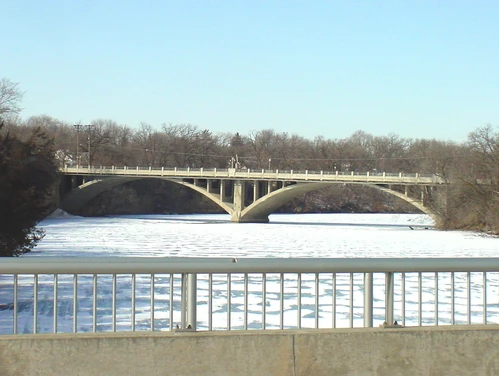- Year constructed: 1934
- Alternate name: Iowa River Bridge
- Bridge type: Concrete Open Spandrel Arch
- National Register of Historic status: Listed
- Length: 380 feet
- Width: 23.8 feet
- Spans: 2
- FHWA: 27000
- Jurisdiction: City of Iowa Falls
- Location: U.S. 20 over the Iowa River in Iowa Falls, Section 13, T89N-R21W (Hardin Township)
Details
This impressive two-span, open spandrel concrete arch crosses the Iowa River in Iowa Falls. Carrying U.S. Highway 20 (Washington Avenue) through the center of the city, the bridge dates to 1934. This structure was preceded by a steel bridge, known locally as the Foster Bridge, whose construction history is well-documented in county records. In late May of 1911 county commissioners adopted plans and specifications for the proposed bridge and immediately advertised for construction bids. Fifteen bids, ranging from $8,450 to $11,400, were received by June. Low-bidder Lana Construction Company of Harlan, Iowa, was awarded the contract, and the company began work soon after. Evidently the Foster Bridge experienced severe problems in the next few decades, and these structural difficulties precipitated construction of a new, permanent bridge in 1933. That year the state highway commission designed this two-span concrete arch structure and hired the Weldon Brothers Construction Company of Iowa Falls to build it. Costing $51,710.55, the Washington Avenue Bridge was ceremoniously opened on July 24, 1934, by Mrs. F.H. Cottrell, wife of the Iowa Falls mayor, with several thousand people in attendance. "I christen thee the Washington Avenue Bridge," she intoned, "a beautiful bridge over a beautiful river." Since its completion, the spandrel arch has functioned in place, carrying heavy urban and highway traffic, with only maintenance-related repairs.
Although highway commission engineers typically used riveted steel trusses for medium-span river crossings in rural settings, they used concrete open spandrel arches for a number of urban and small town structures in the 1920s. The Mederville Bridge, built in 1918, was apparently the first of these, designed as an alternate to a steel truss bridge. This was followed by the Adair Viaduct in 1923 and the Iowa Falls Bridge in 1928. By using open spandrel arches, ISHC could achieve a relatively long span at a reasonable cost, while contributing aesthetically to the urban settings in which the bridges stood. But given the restrictive parameters of the arches' use--urban setting, long-span crossing, sufficient vertical clearance--only a few were built during this period. The Washington Avenue Bridge is distinguished as a well-preserved, two-span example of this application of urban bridge design. A centerpiece for this small city, it is a local landmark and an important transportation-related resource.
Adapted from Crow-Dolby and Fraser 1992
Areas Served
- Hardin
